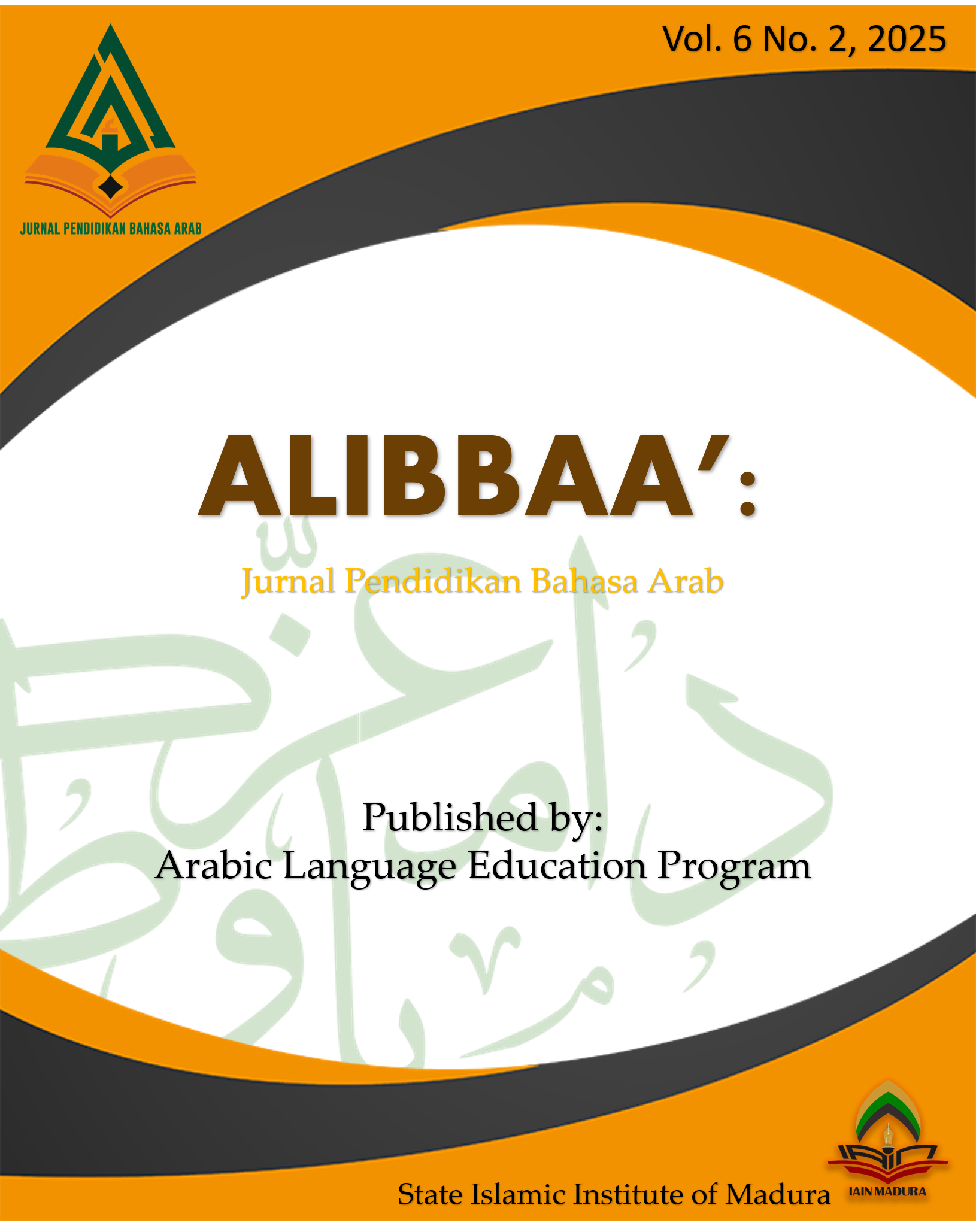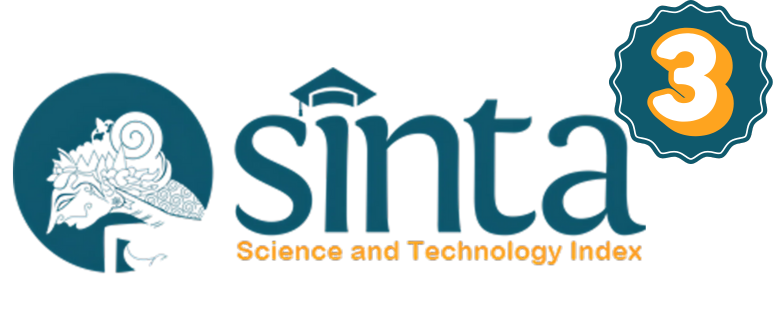Internal and External Barriers to Arabic Reading Mastery: An Empirical Study in an Indonesian Islamic Junior High School
 Abstract views: 209
,
Abstract views: 209
,
 pdf downloads: 133
pdf downloads: 133
Abstract
This study aims to describe the types of difficulties students face in Arabic reading (qirāʾah) skills and to identify the internal and external factors influencing these challenges, including the strategies employed by teachers to address them. Employing a qualitative descriptive approach, data were collected through classroom observation, interviews, and documentation. The research subjects were seventh-grade students at MTs Sirajul Huda Tigabinanga Karo. The findings reveal that students struggle with basic literacy skills such as hijaiyah letter recognition, low motivation, and negative perceptions of Arabic. External factors such as limited teacher availability, inadequate learning support, and scarce instructional materials further exacerbate these difficulties. Nevertheless, teachers have adopted contextual strategies such as daily vocabulary routines and the integration of Islamic values to enhance students’ qirāʾah abilities. This study recommends context-based interventions and institutional support to promote more effective reading instruction in resource-constrained madrasah settings.
Downloads
References
Abou-Elsaad, T., R. Ali, and H. Abd El-Hamid. 2016. “Assessment of Arabic Phonological Awareness and Its Relation to Word Reading Ability.” Logopedics Phoniatrics Vocology 41 (4): 174–180. https://doi.org/10.3109/14015439.2015.1088062.
Afnita, Efrianto, Siti Ansoriyah, Fitriani Lubis, Ifnaldi, Zulfikarni, Jr., V. T. D., S. Mamat, R. H. Ulya, A. Rachman, and F. Nurrahmah. 2025. “Developing CTL-Based Digital Media E-Worksheet for Second Language Learning.” Forum for Linguistic Studies 7 (6). https://doi.org/10.30564/fls.v7i6.9665.
Akmaliyah, A., Y. Hudzaifah, N. Ulfah, and M. I. Pamungkas. 2021. “Child-Friendly Teaching Approach for Arabic Language in Indonesian Islamic Boarding School.” International Journal of Language Education, 501–514. https://doi.org/10.26858/ijole.v5i1.15297.
Albantani, A. M., and A. Madkur. 2019. “Teaching Arabic in the Era of Industrial Revolution 4.0 in Indonesia: Challenges and Opportunities.” ASEAN Journal of Community Engagement 3 (2). https://doi.org/10.7454/ajce.v3i2.1063.
Alsalihi, H. D. 2020. “Main Difficulties Faced by EFL Students in Language Learning.” Journal of the College of Education for Women 31 (2): 19–34. https://doi.org/10.36231/coedw.v31i2.1359.
Bedore, L. M., E. D. Peña, C. Fiestas, and M. J. Lugo-Neris. 2020. “Language and Literacy Together: Supporting Grammatical Development in Dual Language Learners with Risk for Language and Learning Difficulties.” Language, Speech, and Hearing Services in Schools 51 (2): 282–297. https://doi.org/10.1044/2020_LSHSS-19-00055.
Creswell, John W., and Cheryl N. Poth. 2023. Qualitative Inquiry and Research Design. 5th ed. Thousand Oaks, CA: SAGE Publications.
Darvin, Ron, and Bonny Norton. 2023. “Investment and Motivation in Language Learning: What’s the Difference?” Language Teaching 56 (1): 29–40. https://doi.org/10.1017/S0261444821000057.
Dewi, I., Ahmad Nurcholis, Izzatul Laila, Juan Acevedo, and Moumen El-Sayed. 2025. “Curiosity-Driven Learning in Arabic: A Case Study on the ‘Inquiring Minds Want to Know’ Approach.” Alibbaa’: Jurnal Pendidikan Bahasa Arab 6 (1): 42–64. https://doi.org/10.19105/ajpba.v6i1.17881.
Divekar, R. R., J. Drozdal, Y. Zhou, H. Su, Y. Chen, H. Zhu, J. A. Hendler, and J. Braasch. 2022. “Foreign Language Acquisition via Artificial Intelligence and Extended Reality: Design and Evaluation.” Computer Assisted Language Learning 35 (9): 2332–2360. https://doi.org/10.1080/09588221.2021.1879162.
Gharaibeh, Mohammad, A. A. Sartawi, H. Dodeen, and M. Alzyoudi. 2021. “Effects of Rapid Automatized Naming and Phonological Awareness Deficits on the Reading Ability of Arabic-Speaking Elementary Students.” Applied Neuropsychology: Child 10 (1): 1–13. https://doi.org/10.1080/21622965.2019.1585247.
Hadi, N., N. Alvina, and Khaled Radhouani. 2024. “Ta’zîzu Dâfi’iyyati Thullâbi Riyâdh al-Athfâl li Tathwîri Mahârât al-Lughah al-’Arabiyyah al-Syafawiyyah min Khilâli Barâmiji al-Ta’lîm al-Mukatstsaf.” Alibbaa’: Jurnal Pendidikan Bahasa Arab 5 (2): 189–214. https://doi.org/10.19105/ajpba.v5i2.12195.
Harad, Hamsira M., and Benjier H. Arriola. 2022. “Implementation of Arabic Language and Islamic Values Education (ALIVE).” The American Journal of Humanities and Social Sciences Research (THE AJHSSR) 5 (3): 47–57.
Husain, F., and O. Uzuner. 2022. “Transfer Learning Across Arabic Dialects for Offensive Language Detection.” In Proceedings of the 2022 International Conference on Asian Language Processing (IALP), 196–205. https://doi.org/10.1109/IALP57159.2022.9961263.
Jaelani, A., and O. W. Zabidi. 2020. “Junior High School Students’ Difficulties of English Language Learning in the Speaking and Listening Section.” ELT Forum: Journal of English Language Teaching 9 (1): 45–54. https://doi.org/10.15294/elt.v9i1.38287.
Karroum, Amina, Zouhair Ouazene, and Rachida Gougil. 2024. “Relationship Between Arabic Reading Skills and Phonological Awareness in the First Level of Primary School,” 243–252. https://doi.org/10.1007/978-3-031-68653-5_24.
Khuluq, Muchsinul, Moh. Ainin, Abdul Wahab Rosyidi, and Nurul Imamah. 2025. “The Development of Reading Skill Teaching Materials Based on Prezi Artificial Intelligence.” Arabiyatuna: Jurnal Bahasa Arab 9 (1): 327–346.
Khasawneh, Mohammad A. S. 2022. “Language Skills and Their Relationship to Learning Difficulties in English Language from the Teachers’ Point of View.” The Journal of Quality in Education 12 (19): 104–113. https://doi.org/10.37870/joqie.v12i19.308.
Li, Miao, Esther Geva, Nadia D’Angelo, Poh Wee Koh, Xi Chen, and Alexandra Gottardo. 2021. “Exploring Sources of Poor Reading Comprehension in English Language Learners.” Annals of Dyslexia 71 (2): 299–321. https://doi.org/10.1007/s11881-021-00214-4.
Miles, Matthew B., A. Michael Huberman, and Johnny Saldaña. 2014. Qualitative Data Analysis: A Methods Sourcebook. 3rd ed. Thousand Oaks, CA: SAGE Publications.
Milankov, Vesela, Slavica Golubović, Tatjana Krstić, and Špela Golubović. 2021. “Phonological Awareness as the Foundation of Reading Acquisition in Students Reading in Transparent Orthography.” International Journal of Environmental Research and Public Health 18 (10): 5440. https://doi.org/10.3390/ijerph18105440.
Palinkas, Lawrence A., Sarah M. Horwitz, Cathleen A. Green, Jennifer P. Wisdom, Nan Duan, and Kimberly Hoagwood. 2015. “Purposeful Sampling for Qualitative Data Collection and Analysis in Mixed Method Implementation Research.” Administration and Policy in Mental Health and Mental Health Services Research 42 (5): 533–544. https://doi.org/10.1007/s10488-013-0528-y.
Papi, M., and P. Hiver. 2020. “Language Learning Motivation as a Complex Dynamic System: A Global Perspective of Truth, Control, and Value.” The Modern Language Journal 104 (1): 209–232. https://doi.org/10.1111/modl.12624.
Pikri, F. 2022. “The Role of the Language Environment in Improving Arabic Learning Abilities.” International Journal of Science and Society 4 (2): 346–354. https://doi.org/10.54783/ijsoc.v4i2.478.
Safitri, Nanda Siska, Mohammad Rofiqi, Muhajir, Boby Bagas Purnama, and Shosita Manrova. 2025. “TOAFL.com: A CEFR-Based Simulation Platform for Learning Al-Arabiyah Lil Akadimiyah among Indonesian Students.” Alibbaa’: Jurnal Pendidikan Bahasa Arab 6 (1): 1–22. https://doi.org/10.19105/ajpba.v6i1.17201.
Susiawati, I., and Moch. H. Fanirin. 2020. “Arabic Learning at Madrasah Aliyah Based on the 2013 Curriculum.” Arabiyat: Jurnal Pendidikan Bahasa Arab dan Kebahasaaraban 7 (2): 251–263. https://doi.org/10.15408/a.v7i2.17444.
Syaifuddin, Tamam, Luthfiyah Nurlaela, and Sukma Perdana P. 2021. “Contextual Teaching and Learning (CTL) Model to Students Improve Learning Outcome at Senior High School of Model Terpadu Bojonegoro.” IJORER: International Journal of Recent Educational Research 2 (5): 528–535. https://doi.org/10.46245/ijorer.v2i5.143.
Taha, Haitham, Samah Sawaed, and Samaher Jabareen-Taha. 2022. “Are Reading Difficulties Associated With Poor Verbal Learning Skills? Evidence from the Fast-Mapping Paradigm.” Theory and Practice in Language Studies 12 (3): 431–436. https://doi.org/10.17507/tpls.1203.02.
Tari, D. K., and D. Rosana. 2019. “Contextual Teaching and Learning to Develop Critical Thinking and Practical Skills.” Journal of Physics: Conference Series 1233 (1): 012102. https://doi.org/10.1088/1742-6596/1233/1/012102.
Authors who publish with this journal agree to the following terms:
a. Authors retain copyright and grant the journal right of first publication with the work simultaneously licensed under a Creative Commons Attribution License that allows others to share the work with an acknowledgement of the work's authorship and initial publication in this journal.
b. Authors are able to enter into separate, additional contractual arrangements for the non-exclusive distribution of the journal's published version of the work (e.g., post it to an institutional repository or publish it in a book), with an acknowledgement of its initial publication in this journal.
c. Authors are permitted and encouraged to post their work online (e.g., in institutional repositories or on their website) prior to and during the submission process, as it can lead to productive exchanges, as well as earlier and greater citation of published work (See The Effect of Open Access).
Alibbaa': Jurnal Pendidikan Bahasa Arab have CC-BY-SA or an equivalent license as the optimal license for the publication, distribution, use, and reuse of scholarly work.
In developing strategy and setting priorities, Alibbaa': Jurnal Pendidikan Bahasa Arab recognize that free access is better than priced access, libre access is better than free access, and libre under CC-BY-SA or the equivalent is better than libre under more restrictive open licenses. We should achieve what we can when we can. We should not delay achieving free in order to achieve libre, and we should not stop with free when we can achieve libre.

Alibbaa': Jurnal Pendidikan Bahasa Arab is licensed under a Creative Commons Attribution 4.0 International License
You are free to:
- Share — copy and redistribute the material in any medium or format
- Adapt — remix, transform, and build upon the material for any purpose, even commercially.
- The licensor cannot revoke these freedoms as long as you follow the license terms.











